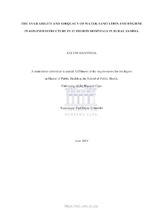| dc.description.abstract | Background and Rationale
The World Health Organization (WHO) has shown that the provision of Water Sanitation and Hygiene (WASH) in Health Care Facilities (HCFs) of many low and middle-income countries is poor. This is compounded by the lack of national plans and consolidated data on WASH in HCFs. This study assessed the availability and adequacy of Water Sanitation and Hygiene (WASH) infrastructure in 13 mission hospitals spanning 13 districts in Zambia. The objectives of this study were to identify the different kinds of WASH infrastructure available, and their adequacy, and factors influencing the status of WASH infrastructure and services in the selected hospitals.
Methodology
This study had a mixed methods design with semi-quantitative, descriptive and qualitative components. Assessments were conducted of the WASH infrastructure on the hospital property, and specifically in the male medical wards and outpatient facilities as two tracer areas, using a WHO checklist adapted and administered by the researcher. Checklist items were assigned scores (0=absent/bad to 2=on target/good) and total WASH scores for each facility compiled. For the qualitative component, individual semi-structured interviews using an interview guide were conducted, also by the researcher, with the facility managers and the head staff of the male medical wards.
Results
Overall coverage with an improved water source was reasonably good with 11 of the 13 hospitals reporting availability of improved water sources within the facilities. Hand washing basin coverage was similarly good. In contrast, coverage by well-functioning toilets was not as high, with 5 hospitals reporting toilets that were either broken, blocked, or having no running water and no toilet paper. Facility
WASH scores varied from 22 (38%) to 57 (97%) out of a possible total of 58 points. Most of the Facility Managers indicated that the hospital WASH infrastructure was old, and with frequent breakdowns. This was worsened by lack of readily available spares and materials for repairing once there was a fault.
Conclusion
This study reveals an uneven coverage of WASH across facilities and elements, with poor sanitation a challenge across facilities. This is compounded by ongoing challenges in WASH infrastructure maintenance. Moving forward, there is need for government to develop a clear policy on WASH in HCFs. A national plan with resources and a monitoring framework need to be in place for streamlined support and tracking of progress by all stakeholders. | en_US |

